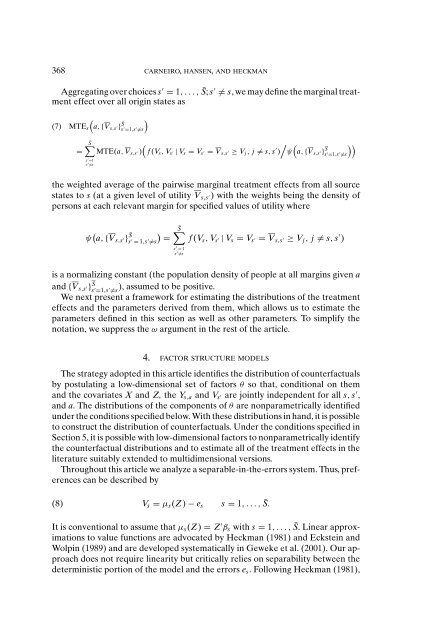Estimating Distributions of Counterfactuals with an Application ... - UCL
Estimating Distributions of Counterfactuals with an Application ... - UCL
Estimating Distributions of Counterfactuals with an Application ... - UCL
Create successful ePaper yourself
Turn your PDF publications into a flip-book with our unique Google optimized e-Paper software.
368 CARNEIRO, HANSEN, AND HECKMAN<br />
Aggregating over choices s ′ = 1,..., ¯S; s ′ ≠ s, we may define the marginal treatment<br />
effect over all origin states as<br />
(7)<br />
MTE s<br />
(a, {V s,s ′} ¯S<br />
s ′ =1,s ′ ≠s<br />
)<br />
=<br />
¯S∑<br />
s ′ =1<br />
s ′ ≠s<br />
(<br />
/ (<br />
))<br />
MTE(a, V s,s ′) f (V s , V s ′ | V s = V s ′ = V s,s ′ ≥ V j , j ≠ s, s ′ ) ψ a, {V s,s ′}<br />
s S ′ =1,s ′ ≠s<br />
the weighted average <strong>of</strong> the pairwise marginal treatment effects from all source<br />
states to s (at a given level <strong>of</strong> utility V s,s ′) <strong>with</strong> the weights being the density <strong>of</strong><br />
persons at each relev<strong>an</strong>t margin for specified values <strong>of</strong> utility where<br />
ψ ( a, {V s,s ′} ¯S )<br />
¯S∑<br />
s ′ = 1,s ′ ≠s = f (V s , V s ′ | V s = V s ′ = V s,s ′ ≥ V j , j ≠ s, s ′ )<br />
s ′ = 1<br />
s ′ ≠s<br />
is a normalizing const<strong>an</strong>t (the population density <strong>of</strong> people at all margins given a<br />
<strong>an</strong>d {V s,s ′}<br />
s S ′ =1,s ′ ≠s<br />
), assumed to be positive.<br />
We next present a framework for estimating the distributions <strong>of</strong> the treatment<br />
effects <strong>an</strong>d the parameters derived from them, which allows us to estimate the<br />
parameters defined in this section as well as other parameters. To simplify the<br />
notation, we suppress the ω argument in the rest <strong>of</strong> the article.<br />
4. FACTOR STRUCTURE MODELS<br />
The strategy adopted in this article identifies the distribution <strong>of</strong> counterfactuals<br />
by postulating a low-dimensional set <strong>of</strong> factors θ so that, conditional on them<br />
<strong>an</strong>d the covariates X <strong>an</strong>d Z, the Y s,a <strong>an</strong>d V s ′ are jointly independent for all s, s ′ ,<br />
<strong>an</strong>d a. The distributions <strong>of</strong> the components <strong>of</strong> θ are nonparametrically identified<br />
under the conditions specified below. With these distributions in h<strong>an</strong>d, it is possible<br />
to construct the distribution <strong>of</strong> counterfactuals. Under the conditions specified in<br />
Section 5, it is possible <strong>with</strong> low-dimensional factors to nonparametrically identify<br />
the counterfactual distributions <strong>an</strong>d to estimate all <strong>of</strong> the treatment effects in the<br />
literature suitably extended to multidimensional versions.<br />
Throughout this article we <strong>an</strong>alyze a separable-in-the-errors system. Thus, preferences<br />
c<strong>an</strong> be described by<br />
(8)<br />
V s = µ s (Z) − e s<br />
s = 1,..., ¯S.<br />
It is conventional to assume that µ s (Z) = Z ′ β s <strong>with</strong> s = 1,..., ¯S. Linear approximations<br />
to value functions are advocated by Heckm<strong>an</strong> (1981) <strong>an</strong>d Eckstein <strong>an</strong>d<br />
Wolpin (1989) <strong>an</strong>d are developed systematically in Geweke et al. (2001). Our approach<br />
does not require linearity but critically relies on separability between the<br />
deterministic portion <strong>of</strong> the model <strong>an</strong>d the errors e s . Following Heckm<strong>an</strong> (1981),
















